The 10 Best Guitar Strings – Recommendations, Categories and a Beginner’s Buying Guide
We may also earn commissions on purchases from other retail websites.

Last Updated Jul-31-2018.
Our biggest article on guitar strings needed no major changes, so we just made a few small tweaks to the content and left things as they were. After all, why fix what is not broken?
What makes a guitar sound great? Body woods, pickups and amps all contribute towards a beautiful tone, but play a $3,000 Gibson with rusty old strings and it won’t sound much better than a thrift store Squier!
That’s right, it’s the strings that truly make the instrument sing, so having a good set on your guitar or bass is crucial for a quality tone.
But when someone asks ‘what are the best strings for me?’, it’s similar to asking ‘what should I wear?’ – it totally depends on the occasion, the temperature, and what you are comfortable in. There’s a big difference between a tuxedo and a muscle vest!And this is the same with the best guitar strings for you. Are you playing a guitar or a bass? An electric or acoustic? A classical or steel-string? Do you prefer metal or blues? Just like there’s no one-size-fits-all guitar, there’s no one-size-fits-all guitar string.
To make things easier to digest – for both experienced players and beginners alike – we’ve compiled a quick chart that features just a small selection of some of the best guitar strings in their respective categories.
We have also gone more in-depth into six broad categories – acoustic, electric, classical, bass, metal and beginners – below the chart, with both string recommendations and what to look out for in these areas. Then stay tuned for a guide on what makes a good string, and how to find the best strings for you.
10 Recommended Guitar Strings In This Article:
| Image | Guitar Strings / Rating | Summary | Check Price |
|---|---|---|---|
+ -  | D'Addario EJ16-3D Phosphor Total of 4.80/5 | Fresh, light gauge (.012-.053) acoustic strings made from phosphor bronze. | |
+ -  | Martin-MSP4100 Total of 4.70/5 | Long life phosphor bronze acoustic strings with a light gauge (.012-.054). | |
+ -  | D'Addario EJ17-3D Total of 4.70/5 | Medium gauge (.013-.056) phosphor bronze strings made in US. | |
+ -  | Ernie Ball 2221 Regular Slinky Total of 4.60/5 | Popular regular gauge (.010-.046) electric guitar strings played around the world. | |
+ -  | DR NMCE-10 DR Neon Total of 4.70/5 | Popular bass strings, with a medium gauge (.045-.105) and bright tone. | |
+ -  | Fender 3150R Original Bullets Total of 4.80/5 | Classic Fender bullets, made from nickel with a light gauge (.009-.042). | |
+ -  | Augustine Classic-Red Total of 4.70/5 | Medium tension copper-wound classical nylon guitar strings. | |
+ -  | Ernie Ball 2834 Super Slinky Total of 4.70/5 | Popular light gauge (.045-.100) electric bass strings made in America. | |
+ -  | D'Addario EXL230 Total of 4.60/5 | Top-selling heavy gauge (.055-.110) roundwound bass strings. | |
+ -  | DR Strings Dimebag Darrell Signature Total of 4.70/5 | Excellent heavy metal strings with a hybrid gauge of .010-.052. |
Acoustic Strings
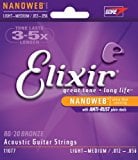 With acoustic guitars, you have two very different options: steel or nylon strings. This section will cover steel-stringed guitars, while nylon strings will be discussed in the classical guitars section below.
With acoustic guitars, you have two very different options: steel or nylon strings. This section will cover steel-stringed guitars, while nylon strings will be discussed in the classical guitars section below.
With a steel-string acoustic, you are ideally looking for a crisp, bright, focused sound that would work well for all acoustic styles, from blues and rock, to fingerstyle and high-paced chicken pickin’. However, different body styles usually call for different gauges of string.
For example, a dreadnought body – which is designed to offer lots of resonance – will be best strung with medium and heavier gauge strings (such as Elixir Light Nanoweb 80/20 Medium) to achieve a louder sound. A large Grand Auditorium body guitar is also suited to heavier gauge strings, while the smaller parlor guitars and travel acoustics are best strung with lighter gauge strings, such as a set of D’Addario EJ16-3D.
The majority of strings in this category will be made with bronze, phosphor bronze, or aluminum bronze, which – as we have mentioned earlier in this article – have different characteristics depending on the materials. For example, bronze is clear and bright, phosphor bronze offers a warmer tone, while aluminum bronze tends to give a crisper sound.
Consider coated acoustic strings – such as Elixir’s 80/20 Bronze Strings – for a longer lasting string, which are perfect if you hate changing your strings or don’t play very often.
Electric Strings
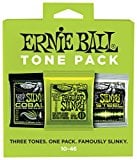 When you’ve found your favorite electric guitar you’ll need to stock up on a few sets of strings, because they have the tendency to break at the worst possible time! But it’s not just about breakages – there’s no better feeling for a guitarist than playing that first lick on a slick pair of brand new strings.
When you’ve found your favorite electric guitar you’ll need to stock up on a few sets of strings, because they have the tendency to break at the worst possible time! But it’s not just about breakages – there’s no better feeling for a guitarist than playing that first lick on a slick pair of brand new strings.
As we’ve discussed, there are many different materials, gauges and styles of electric guitar string, so it’s ultimately down to you to decide what you like. If you aren’t sure what tone you prefer, a great way to sample a variety of strings is to go for something like Ernie Ball’s ‘Tone Pack’, offering three sets of different strings that vary in tone, output and stability.
If you enjoy playing modern rock you’ll want to consider a heavier string to cope with harder, faster playing, as they are less prone to breaking than lighter strings. Heavier strings – such as D'Addario EXL145 Heavy – also cope better with lower tunings.
On the other hand, lighter strings are much easier to bend and play with, and are perfect for beginners as well as fast lead players, even if they have a tendency to break easier than heavier strings. If breakages are a big concern for you, D'Addario’s NYXL light strings are made with high carbon steel alloy for super strength.
Classical Strings
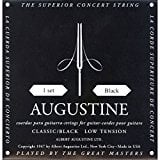 Unlike steel-string acoustic guitars, classical guitars demand a nylon string – using steel on a classical guitar can result in a damaged instrument, so don’t try it!
Unlike steel-string acoustic guitars, classical guitars demand a nylon string – using steel on a classical guitar can result in a damaged instrument, so don’t try it!
Nylon strings are renown for producing the warm, smooth, mellow tones needed for classical, flamenco, bossa nova, and folk music, and are also popular with beginners as they are slightly easier to play when first starting out.
The prime difference in classical guitar strings will be the tension: usually low, normal and high. Low tension strings – such as Augustine AUGBLKSET – are easier to fret, although don’t have the projection and volume you’d find with higher tension sets. Without trying a few different tensions, it will be hard to determine what you prefer, although a good medium (or ‘normal’) tension string, like a set of D'Addario EJ45 Pro-Arte strings, are usually a good call if you aren’t sure what will suit your playing style.
Although they are called nylon strings, materials can vary. In the majority of cases you’ll find the treble strings are made from nylon, carbon, or other synthetic materials, while the bass strings are made with a nylon core wrapped in bronze or silver-plated copper wire. Different materials, just like tensions, give different feels and tones, and finding the best one for you will take a little experimentation.
Bass Strings
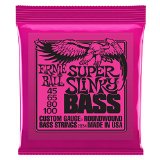 As with all guitar strings, finding the right set of strings for your bass is important. And, like guitar, bass strings vary in gauge, materials, and winding.
As with all guitar strings, finding the right set of strings for your bass is important. And, like guitar, bass strings vary in gauge, materials, and winding.
It’s useful to start by determining what gauge string you’ll need, as this will impact both the tone and the feel. A set of medium strings, with a typical gauge of around .045-.105, are a good place to begin as these will allow easy playing with enough versatility in tone for most styles. In this category, Ernie Ball’s Super Slinky Bass Stringс are a good choice.
If you are more of a lead bass player, playing walking bass lines and using lots of slapping, a set of lighter strings would be most suitable. However, at the opposite end of the spectrum, if heavy rock or metal is more your style, a set of heavy or extra-heavy strings – with typical gauges of around .055-.115 (such as Dunlop’s DBN55115) – would be more suitable, as they allow for thicker tones and lower tunings.
Another thing to consider is the material used to make the string. Nickel-plated steel strings offer a well-balanced tone and are a popular choice with most bassists. Stainless steel – which are very bright – are a favorite with heavier bassists, playing rock and metal, while pure nickel strings have mellower tones, and are popular with country players.
Metal Strings
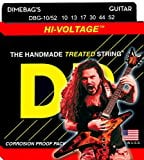 We have a section dedicated to one specific genre of music: metal. Modern heavy rock and metal are notorious for using super low tunings and heavier strumming to get that awesome dark, powerful sound. Therefore, metal guitarists demand a heavier string to cope with this aggressive style of playing.
We have a section dedicated to one specific genre of music: metal. Modern heavy rock and metal are notorious for using super low tunings and heavier strumming to get that awesome dark, powerful sound. Therefore, metal guitarists demand a heavier string to cope with this aggressive style of playing.
A prime reason for using a heavier string is that, when tuned low, light or medium strings won’t offer enough tension and will tend to flap around – the so-called ‘cooked spaghetti’ effect. The heavier string is also less prone to sudden breakages when strummed aggressively, compared to a regular set of strings. Heavier strings also offer a fuller, thicker tone, which is what metal is all about.
Unfortunately, heavier sets of strings – while excellent for aggressive rhythm playing – can be harder to play when the time comes for lead licks and solos, with string bending and general fretting tougher on the fingers. This is why many brands now offer hybrid string sets, which use heavy gauges on the bass strings to accommodate for powerful playing, while the treble strings use lighter gauges to make fast lead playing easier.
A good place to start when it comes to strings for metal is with DR Strings’ Dimebag Darrell Signature series, and make sure to check out Stringjoy’s Light Top / Heavy Bottom Hybrids.
Beginners Strings
When just beginning your guitar journey, you will need a good set of strings that will be easy to play. Whether you are an adult beginner or shopping for a child, we always recommend light or extra light strings when it comes to both electric guitar (usually a gauge of .009-.042.) and steel-string acoustics (around .012-.053). These strings will also work well for short scale guitars or guitars for kids. For beginners to the electric guitar, you cannot go wrong with a set of D’Addario NYXL0942 Extra Light strings, while acoustic guitar beginners will find a set of D’Addario EXP10 Coated Extra Light strings more than suitable.
If you are learning or buying for a classical guitar (with nylon strings), then know that – while gauges are pretty much the same across the board – string sets differ in tensions. Therefore, we advise opting for a set of low/light tension strings as these are easier to fret. Something like a set of Augustine’s AUGBLKSET will work nicely for beginners, although a set of D’Addario EJ27N Student strings are great for ½-sized guitars.
As for beginner’s bass strings, we say light is right! That’s why we recommend something like a set of Ernie Ball’s Super Slinky Bass Strings, which – as the name suggest – are light and very easy to play.
A Beginner’s Guide to Buying The Right Guitar Strings
There are several things to look out for when purchasing a set of guitar strings. Although we focus on each style of guitar – from classical to bass – in their respective categories below and on their dedicated pages, here are a few general things to look out for when buying strings, especially if you are doing it for the first time.
Gauges
While we’ll discuss many different gauges – or thickness – of string on this page, be aware that there is no defined gauge. By this we mean that Elixir’s medium strings may not be the same thickness as Fender’s, D'Addario’s, or Ernie Ball’s mediums.
The gauge of a string is usually listed in the format 10-46 or .010-.046. and refers to the size of the string, measured in 1/1000th’s of an inch (the .010 would be the highest string in the set, with the .046 the lowest). In general, gauges vary from the lightest .008 on the first string right up to .056 on the heaviest sixth string, although you can find heavier gauges as you move into seven string guitars.
Be aware that acoustic strings usually have thicker gauges than electric guitar strings – so a set of light acoustic strings may be .012-.053, whereas a set of light electric strings would be .009-.042.
Heavy: Whatever guitar you play, heavier strings are superb for powerful, aggressive strumming and low tunings (heavy metal and rock in particular), because they are more resistant to breakages while keeping string tension high. Heavier strings on an acoustic guitar can lead to more resonance and projection, so are excellent for unplugged playing.
Light: In general it’s easier to play with lighter strings, as it takes less effort to fret and bend them, making them perfect for lead players, shredders and beginners who struggle with heavier gauges. They are also essential for vintage guitars as they exert less tension on the guitar’s neck.
Medium: The balanced choice – easier playing than heavier strings, but with more tone and durability than light strings.
Hybrid: Another way to get the best of both worlds is by going for a hybrid set, that offer heavier bass strings in the same pack as lighter treble strings. The result is a guitar that allows for aggressive rhythm playing and easy soloing, making them perfect for metal players.
Materials
As well as different gauges, strings come in different materials that will change either subtly or dramatically from instrument to instrument.
Electric and Bass Guitars: Several metals can be used to make effective strings for electric and bass guitars, with the most popular choice among both guitarists and bassists being nickel-plated steel, which are well-balanced between warm and bright tones. Other metals used include pure nickel strings (which have a warmer tone) and stainless steel (brighter than the others), as well as chrome, titanium, cobalt, and copper-plated steel.
Acoustic (Steel String): The two most popular materials used for acoustic strings are bronze and phosphor bronze (as well as plain steel, used on the treble strings). Bronze is often referred to as 80/20 bronze as it comprises 80 percent bronze with 20 percent made from zinc. These 80/20 strings offer a bright and crisp sound, although don’t have a very long life. Phosphor bronze – which lose a little brightness in comparison – last much longer, as the metal is protected from oxidization. Finally, compound strings also exist, which are essentially a hybrid between metal and nylon strings, and are useful for softer playing styles.
Classical (Nylon String): As you may expect, the treble strings on a classical guitar are, more often than not, made with nylon, which provides a good balance between warmth and brightness, while offering solid projection. You can also find black nylon, which is a little warmer than clear nylon, and composites. As for the bass strings on a classical guitar, 80/20 bronze is the most popular material as it’s bright and projects well, while silver-plated copper offers a warmer tone.
Coating
In addition to looking at what material the string is made of, you will want to check if it features a special coating for protection and/or aesthetic purposes.
These ‘coated’ strings are covered with a micro-thin polymer that give the strings a longer lifespan and a smoother feel, as well as reducing unpleasant squeaking. However, the trade-off is that coated strings are said to offer less brightness and sustain, while also being more expensive to buy.
In this area you can also find some cool eye-catching coatings, such as multi-colored strings, a variety of neon strings, or even all-black strings, that give all kinds of guitar a visual boost, and are great for learning the instrument as well as performances.
A pack of multi-colored neon strings – such as this set of DR Strings NMCE-10 DR – will always turn heads!
String Core and Winding Method
If you are buying strings for the first time, your decision will most likely be made on the basis of gauges/tensions, materials, and even coatings and colors. It’s unlikely the winding method and string core will sway your decision too much, but it’s still worth understanding the basics of these two elements of string construction.
String Cores: On electric, bass, and steel-string acoustics, strings will be made with either a round core or hex core, referring to the cross-section shape of the steel (the majority of classical guitar strings tend to have simple nylon cores). Round cores used to be the norm, but hex cores – which were introduced to make the string manufacturing process easier – now tend to be the most popular kind of string core. They each have their own advantages, with hex cores offering a brighter, more consistent tone with a stronger attack. Round core strings are popular with guitarists seeking a more vintage tone, as they are warmer and gentler, even if a little less consistent.
String Winding: The way metal is wound around the string’s core is another factor to consider, and there are three methods: roundwound, flatwound, and halfround. Of the three, roundwound – where a round wire is wrapped around the core – is the most popular among electric guitarists, as they are brighter, have more grip, and are cheaper to produce. Flatwound strings – where the wire wrapped around the core is flat – provides a smoother surface, promoting a longer string life (as they are more resistant to dirt build-up) and a warmer sound, and are typically popular with bassists. Halfround strings have a square cross-section, and are essentially a mix of the other styles – smooth to play, but with some of the tonal characteristics of a roundwound string.
Now you have a little more information about strings in general, you can go back at the best strings for specific instruments. Make sure to check out the complete articles for a more in-depth look.
The Final Word
At GuitarFella we could write a book on the advantages and disadvantages of every string style – the amount of different gauges, materials, coatings, cores, and winding methods result in an endless spectrum of tone. However, for someone new to buying strings, the guide on this page is more than you need to know, and will hopefully have given you an idea of what will work best for you.
It’s important not to get too bogged down with the choice of string. Read a little, watch a few reviews, but then go buy a few packs. Try out a few different materials and gauges, and you’ll soon find something you like. Just like shopping around for different guitar effects pedals it’s unlikely that you will settle with your first choice, but there’s lots of fun to be found in the experimenting stage!
If you are a beginner, having face-to-face or online guitar lessons will be more beneficial to you in the early days than finding the perfect string. However when you do find it, you’ll be one happy guitarist. Good luck with your string shopping!
Finally, here is a helpful video that runs you through the art of buying strings for an acoustic guitar for the first time:






Alex says
Hallo my name Alex from Indonesia.
I have a question ..Can I use super extra light steel strings (0.08 -….) on my Guitalele Yamaha GL1….thank you very much sir..
Barbara Brush says
That was VERY interesting. I have been playing the guitar for many years and never knew any of that information on the strings. I look forward to experimenting.
Gail says
Can you please recommend specific strings, including model numbers, for a child’s 20″ guitar? I read what you said about flat wound and high tension hard strings, but truthfully, I get lost in the descriptions because they are so technical, so that I’m worried I’ll waste my money on the absolute wrong ones.
Kim says
Hi, i have inherited a pack of strings and have just stared to play a guitar. On the pack it states 80/20 Bronze wound light gauge 6 strings by Martin strings. Are these strings good for a beginner?
Kenneth Alcorn says
I can safely say that the best sounding guitar strings i have ever strung my semi acoustic guitar with,would be Jazz strings, Fab! But not very popular!! Kenny Denistoun, (Born in Glesga! born country )